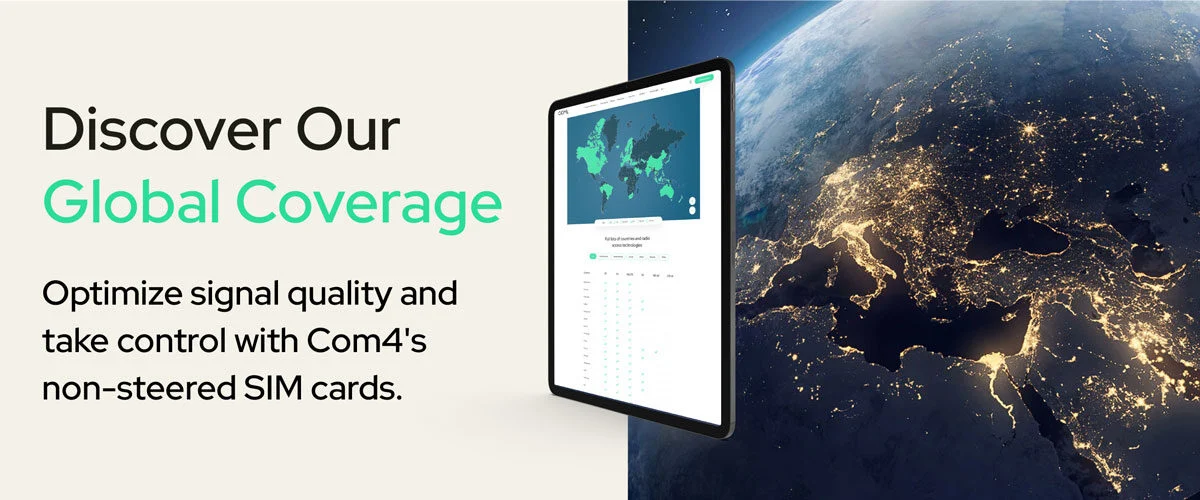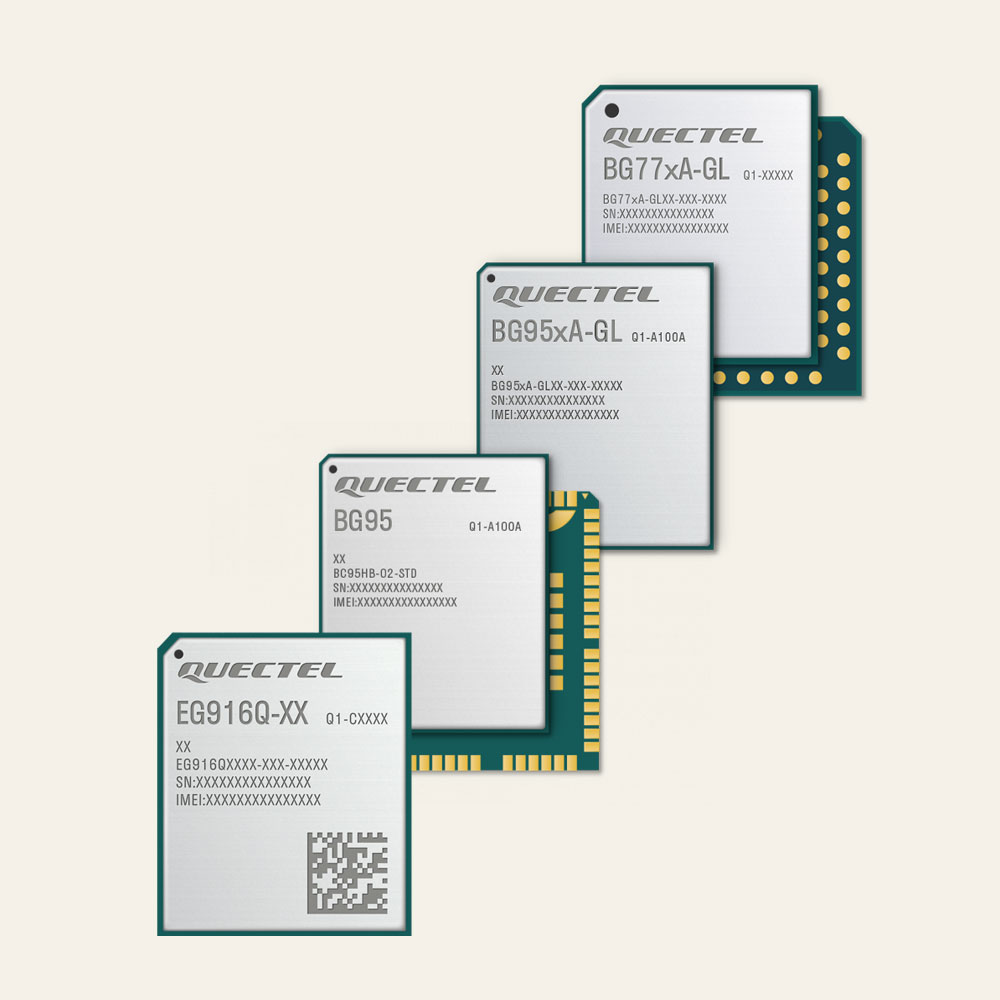All these parts help ensure smooth data transmission and connectivity. From industrial automation to smart cities and fleet management, choosing the correct IoT hardware is critical to maintaining efficiency, security, and scalability. This article looks at the main parts of IoT hardware. It explains how they work and what to think about when choosing devices for your IoT setup.
What is a Cellular Modem?
A cellular modem is the device that has the role of connecting your product to a mobile network, and wirelessly (modulate and demodulate) your data between your product and the network. They usually include an RF-frontend and an interface for your embedded system to communicate with.
Cellular modems come with different support for one or multiple Radio Access Technologies, like 2G, LTE, NB-IoT, LTE-M, 5G & Redcap. And they span from simple and small cost-effective modem-only chips to full SoC with GNSS support and microcontroller to run your application on.
Selecting the right cellular modem module for your embedded product is crucial for the success of the project.
What is a Cellular Router?
A cellular router is usually a Commercial Of The Shelf (COTS) device that is used to securely connect existing products and infrastructure to the mobile network.
Industrial cellular routers and gateways are produced to be capable of being in service for longer periods in remote areas, without need for any local maintenance.
As they rely on cellular modems, the same applies here with support for one or more different Radio Access Technology. And the choice of product can be done based on network coverage and data throughput needed.
Other features that are available on industrial cellular routers, are the various interfaces to connect to. This ranges from one or several LAN-ports, Wifi, GPIO, RS-485 and Modbus to monitor and control a wide range of existing 3rd party equipment.
The Role of IoT Antennas
IoT antennas play a crucial role in ensuring reliable connectivity and signal strength for IoT devices. The choice of antenna can greatly affect how well an IoT solution works. It influences data speed, coverage, and network efficiency. There are different types of antennas used in IoT applications:
- External Antennas – These antennas are mounted outside devices to maximize signal reception, often used in industrial IoT applications where strong connectivity is required.
- Embedded Antennas – Integrated within IoT devices, these antennas are optimized for compact designs, balancing performance and space constraints.
- Directional vs. Omnidirectional Antennas – Directional antennas send signals in one direction. They are great for fixed setups. Omnidirectional antennas cover 360 degrees. They work well for mobile or spread-out uses. Proper antenna selection and placement are critical to minimizing interference, optimizing performance, and ensuring seamless communication.
Key Differences Between Traditional and IoT-Focused Hardware
While traditional modems and routers are designed primarily for consumer use, IoT-focused hardware is tailored to meet the specific demands of industrial and large-scale IoT applications:
- Connectivity: A wide range of cellular modems with various features is available in the market, enabling the capabilities of a global IoT product.
- Functionality: IoT routers often support various communication protocols, including Wi-Fi, Bluetooth, LoRa, and cellular networks (LTE, 5G, NB-IoT), providing flexibility for diverse IoT environments.
- Security: Enhanced security features such as multi-tunnel VPN support, firewall protections, and intrusion detection systems are commonly integrated into IoT routers to safeguard critical data and infrastructure.
- Durability: IoT hardware is often built to withstand harsh environmental conditions, including extreme temperatures, dust, and moisture, ensuring reliable operation in industrial settings.
Choosing the Right IoT Hardware Selecting appropriate IoT hardware is crucial for the success of any IoT deployment. Consider the following factors:
- Application Requirements: Determine the specific needs of your IoT application, including data transmission rates, network coverage, and environmental conditions.
- Scalability: Ensure the hardware can accommodate future expansion, supporting additional devices and increased data traffic.
- Compatibility: Verify that the hardware supports the necessary communication protocols and can integrate seamlessly with existing systems.
- Security: Assess the security features to protect against potential threats and unauthorized access.
- Support and Maintenance: Consider the availability of technical support, firmware updates, and warranty options from the hardware provider.
By carefully evaluating these factors, businesses and individuals can select IoT hardware that not only meets their current requirements but also provides a reliable foundation for future technological advancements.
Understanding the distinctions and functionalities of cellular modems and routers is fundamental in navigating the complex landscape of IoT hardware. Making informed decisions in hardware selection ensures robust, secure, and efficient connectivity solutions tailored to specific application needs.

Com4 works with several leading IoT hardware brands, including:
- Teltonika – Specializing in industrial-grade routers, gateways, and modems for IoT and M2M applications.
- Quectel – Offering a wide range of cellular, GNSS, and IoT modules, as well as antennas and related hardware. Antenna design is critical for optimal performance, and Quectel provides guidance on OEM antenna solutions.
- Kigen – A key partner for iSIM technology, enabling embedded SIM solutions for IoT.
- Starlink – Providing satellite connectivity for IoT applications in remote locations.
- Advantec – Delivering advanced connectivity solutions for industrial and IoT applications.
- Panorama Antennas – Offering high-performance external antennas for IoT applications, ensuring optimal signal strength and connectivity.
- Zyxel– Providing Fixed Wireless Access solutions for high-speed and reliable IoT connectivity.
- Thales – A global leader in embedded and integrated security, offering eSIM, iSIM, and secure connectivity solutions for IoT, M2M, and mission-critical applications. Thales plays a pivotal role in enabling secure digital identity and remote SIM provisioning.
These brands help Com4 deliver robust and scalable IoT connectivity solutions for various industries, including smart cities, industrial automation, fleet management, and more.

 CASE STUDY
CASE STUDY




